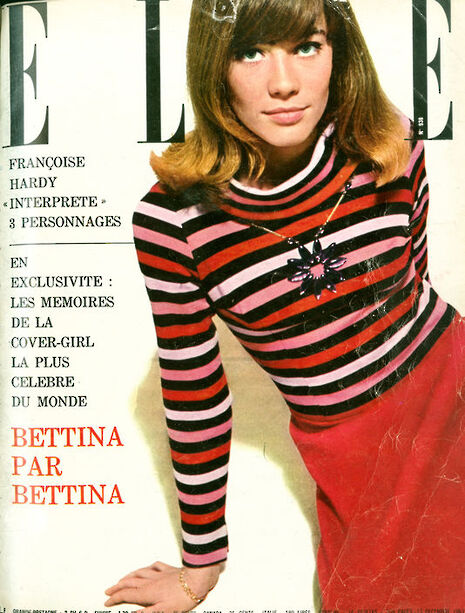All hail the ‘Queen of Knitwear’
Flora Walsh bids adieu to the late Sonia Rykiel, one of world’s most influential designers

From her flame red bob to her slept-in smoky eyes and birdlike frame, Sonia Rykiel was as iconic as the designs she created. Today her influence shows no sign of fading from the catwalk or society. Her thought-provoking designs, strident sense of style and captivating appreciation of the female form have earned her a permanent place amongst the royalty of fashion.
Sonia Rykiel (nee Fils) was born on 25th March 1930, the eldest of five, red-headed daughters in a Jewish family in Neuilly-sur-Seine. Her father was a Romanian watchmaker and her mother was a Russian lady of leisure. However, during the Second World War, her artistic Jewish family had to maintain an oppressive level of discretion, if not quite retreating into hiding. After the war was over, Sonia was employed to create the window displays for the Grande Maison de Blanc in Paris. In 1953, she married Sam Rykiel, the owner of the clothing boutique, Laura. They had two children, Nathalie and Jean-Philippe. The Sonia Rykiel label was founded in 1968 upon the opening of her first boutique, following her divorce. In 2012, Rykiel announced that she was suffering from Parkinson's disease, having handed over the creative direction of the label to her daughter in 2007. She died from complications of the disease on 25th August 2016.
It was while she was pregnant with Jean-Philippe in 1962 that she first turned to design. Maternity wear had previously been designed to conceal the swelling female form, which Rykiel dismissed as “abominable.” She instead designed a series of sweaters with the arm holes cut high, the sleeves fit tight and the body short and fitted. To the horror of her mother-in-law, these sweaters clung to every curve of her changing shape. Later, she reworked the design of the sweaters with an Italian company to produce the iconic ‘Poor Boy’ sweater. They were an instant hit, culminating in Françoise Hardy’s Elle Paris cover, where she wore a pink, black and red Poor Boy sweater. The unprecedented success of her knitted designs earned her the title “Queen of Knitwear” in a feature from Women’s Wear Daily.
During the 1960s, fashion was entering a new era of named-designer prêt-à-porter. These new labels were “younger, faster, cheaper, sexier, yet more intellectual” than the existing couture houses, requiring a designer to create cuts that would work for women of different shapes and ages. Rykiel opened her first prêt-à-porter boutique on the Rue de Grenelle in May 1968, in the heart of Paris’ artistic underworld. At the time, student riots raged throughout the district and it was in the midst of this social and political upheaval that Rykiel made her mark as a forward-thinking designer.
While Rykiel’s designs were very much a reflection of her times, they were remarkably prescient. Although Yves Saint Laurent, a close friend of Rykiel, is celebrated for putting women in trousers in the late 1960s, Rykiel had already upended the constraints of post-war fashion in anticipation of the gamine, unisex style of the latter 20th century. The fit of the Poor Boy sweater allowed women to embrace the ‘bra-burning’ age of the 1960s. She irreverently named this approach ‘la démodé’ (‘non-fashion’), a style that became synonymous with the women’s liberation movement, free from constrictive clothing and social tropes.
She applied the philosophy to her catwalk as well as to her collection, directing models to stroll down the runway in groups, smiling, giggling and chatting, a far cry from the frosty strut of couture shows. Many staples of today’s runway are the progeny of Sonia Rykiel: the technique of exposed seams, the slogan sweater and, most significantly of all, the popularisation of the colour black for women’s daywear.

For the 40th anniversary of the label in 2008, Nathalie secretly commissioned leading designers to create looks inspired by her mother’s designs. The contributions of Jean Paul Gautier, Martin Margiela and Ralph Lauren, among many others, demonstrated the influence and admiration she had engendered.
Just as Sonia Rykiel was a product of her time, her time was a product of her design. From the artistic and cultural oppression of the Second World War, she burst into the women’s rights movement with unrivalled style and clarity. A writer as well as a designer, she filled her shop with her books, including an erotic novel which was ground-breaking in its empowerment of the female role in sex and society. Her very first slogan sweater bore the word “sensuous”, which undoubtedly described both her and her clothes in her characteristically witty, modern and defiant style.
 Features / The community Cambridge accommodation creates (and doesn’t)9 August 2025
Features / The community Cambridge accommodation creates (and doesn’t)9 August 2025 News / Trinity sells O2 Arena lease for £90m12 August 2025
News / Trinity sells O2 Arena lease for £90m12 August 2025 Lifestyle / An ode to college accommodation11 August 2025
Lifestyle / An ode to college accommodation11 August 2025 Sport / ‘A full-time job with overtime’: should disparities change the way we approach Bumps?6 August 2025
Sport / ‘A full-time job with overtime’: should disparities change the way we approach Bumps?6 August 2025 Features / Incoming freshers and their hopes, fears and expectations for Cambridge 12 August 2025
Features / Incoming freshers and their hopes, fears and expectations for Cambridge 12 August 2025









